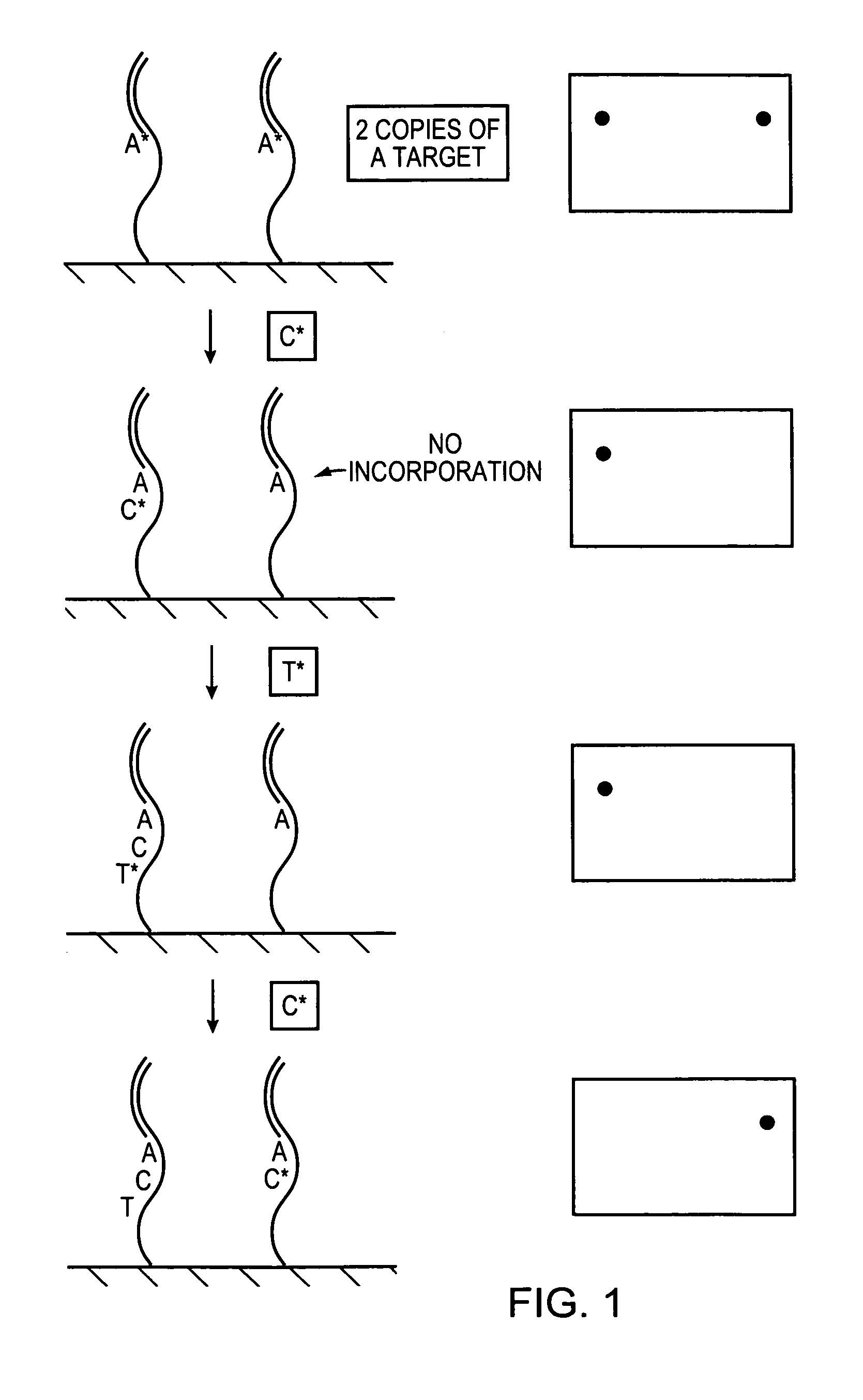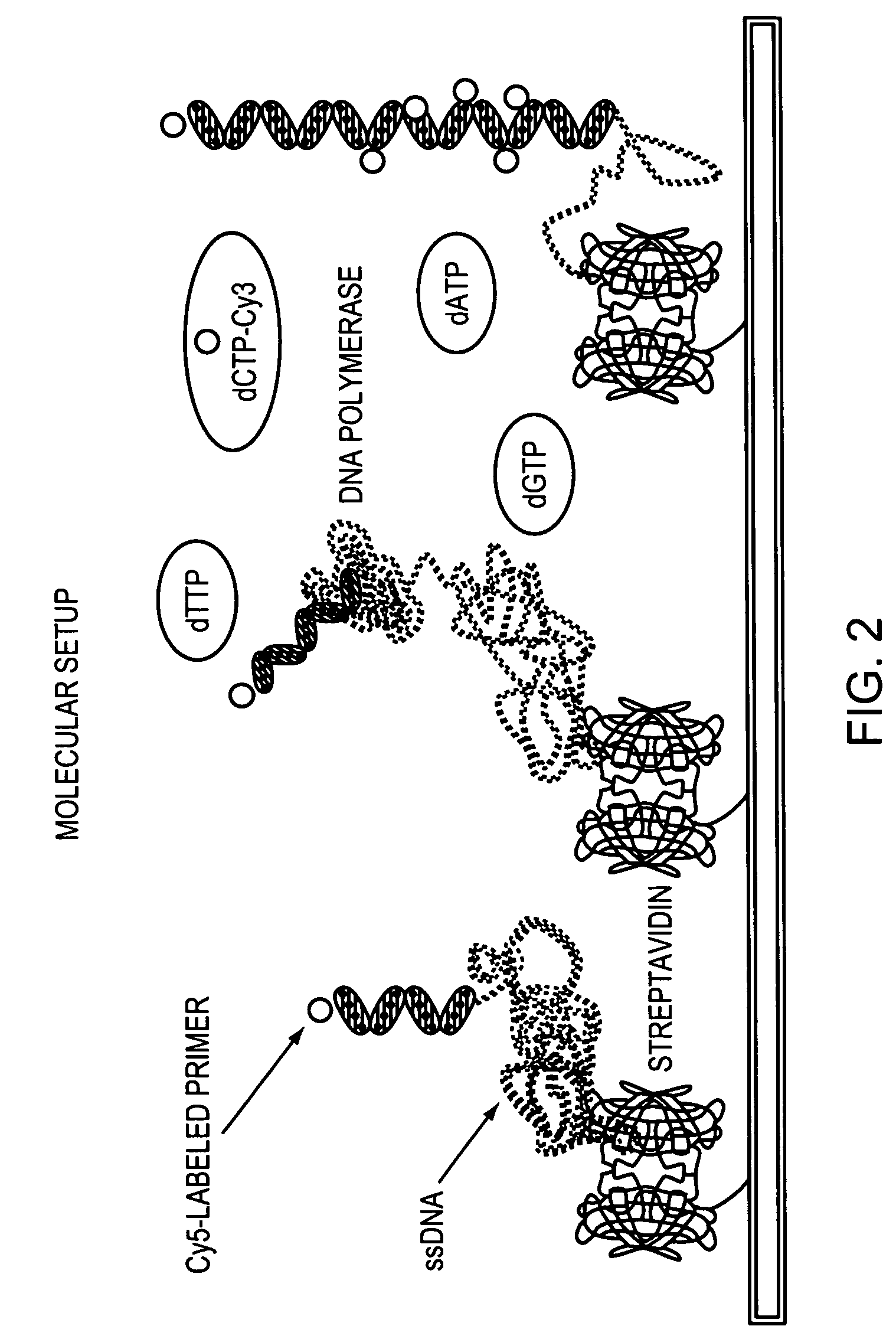Methods and devices for nucleic acid sequence determination
a nucleic acid and sequence determination technology, applied in the field of methods and devices for sequencing a nucleic acid, can solve the problems of affecting the effective diagnosis and management of important diseases through single molecule sequencing, affecting the ability of the overall charge layer to adhere, and affecting the implementation of tools and methods that are not cost-effective, so as to improve the ability of the surface attachment layer to adhere, facilitate the overall charge layer, and improve the effect of rinsability
- Summary
- Abstract
- Description
- Claims
- Application Information
AI Technical Summary
Benefits of technology
Problems solved by technology
Method used
Image
Examples
example 1
[0113]Amine-modified oligonucleotides were attached to the aldehyde-modified ‘SuperAldehyde’-slides (TeleChem International Inc., Sunnyvale, Calif.; lot numbers 000529 and 000831) according to the protocol given by the manufacturer. The oligonucleotide concentration was 25 μM in 0.5× ArrayIt Micro spotting solution (TeleChem International Inc., Sunnyvale, Calif.). To remove the unbound oligonucleotides after spotting and deactivate the excessive aldehyde groups, the slides were processed as described in the protocol: washed twice in 0.2% sodium dodecyl sulfate (SDS) for 5 minutes each, twice in dH2O for 5 minutes each and once in a solution containing 0.25 g Na2BH4 dissolved in 75 ml phosphate-buffered saline (PBS) and 25 ml EtOH for 5 minutes. Additionally the slides were washed three times in 0.2% SDS for 1 minute each and twice in dH2O for 1 minute each. These slides were denoted ‘SuperAldehyde 1’. One modification employed to this protocol involved the incubation of slides in 0....
example 2
[0114]Aminemodified oligonucleotides were attached to the 3D-Link™-slides (SurModics, Inc., Eden Prairie, Minn.) according to the protocol given by the manufacturer. The oligonucleotides were dissolved in 150 mM sodium phosphate buffer pH 8.5 at a 25 μM concentration. After printing the arrays were stored for 4-72 h in a chamber with 75% relative humidity (SurModics, Inc., Eden Prairie, Minn.). The excess amine-reactive groups were deactivated for 15 minutes at 50° C. in a solution containing 50 mM ethanolamine, 0.1 M Tris-HCl pH 9.0 and 0.1% SDS. The slides were washed with dH2O, in a solution containing 4×SSC and 0.1% SDS at 50° C. for 15-60 minutes and finally with dH2O. The slides were stored desiccated at 20° C. until use.
example 3
[0115]Nucleotides attached to mercaptosilane-derivatized slides (Orchid Bioscience, Inc., Princeton, N.J.) were modified with 5′ disulfide groups (Operon Technologies, Inc., Alameda, Calif.) and diluted to a concentration of 25 μM in 0.5 M sodium carbonate buffer (pH 9.0) and 0.02% SDS. After spotting, the slides were kept in a chamber with 75% relative humidity for 5 minutes to overnight. The slides were then washed three times with a solution containing 10 mM Tris-HCl pH 7.5, 150 mM NaCl and 0.05% Tween-20. After washing with dH2O the slides were left to dry and stored at 20° C. until use. For attaching acrylamide-modified oligonucleotides (Sigma-Genosys Ltd, Cambridge, UK) to the mercaptosilane-surfaced slides the oligonucleotides were dissolved as for attachment to the EZ-RAYS™-slides (Mosaic Technologies, Waltham, Mass.), see below. The post-spotting procedures were the same as those described for the disulfide-modified oligonucleotides
PUM
| Property | Measurement | Unit |
|---|---|---|
| concentration | aaaaa | aaaaa |
| pH | aaaaa | aaaaa |
| pH | aaaaa | aaaaa |
Abstract
Description
Claims
Application Information
 Login to View More
Login to View More - R&D
- Intellectual Property
- Life Sciences
- Materials
- Tech Scout
- Unparalleled Data Quality
- Higher Quality Content
- 60% Fewer Hallucinations
Browse by: Latest US Patents, China's latest patents, Technical Efficacy Thesaurus, Application Domain, Technology Topic, Popular Technical Reports.
© 2025 PatSnap. All rights reserved.Legal|Privacy policy|Modern Slavery Act Transparency Statement|Sitemap|About US| Contact US: help@patsnap.com



